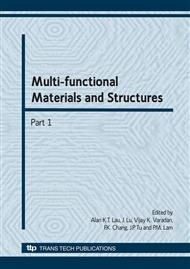p.1387
p.1391
p.1395
p.1399
p.1403
p.1407
p.1411
p.1415
p.1419
Characteristics and Chemical Stability of the Bioactive Titania Layer Formed on Ti, Ti-6Al-4V and NiTi SMA through a Low Temperature Oxidation Process
Abstract:
To improve the biocompatibility and bioactivity of titanium and titanium alloys, a titanium oxide layer was synthesized on Ti, Ti-6Al-4V and NiTi shape memory alloy (SMA) using a H2O2-oxidation and hot water aging technique. The surface of these metals before and after the oxidation treatment was characterized using scanning electron microscopy and energy dispersive X-ray spectroscopy. Because of the synthetic titanium oxide surface layer, the Al and V contents on the surface of as-oxidized Ti-6Al-4V decreased significantly. Similarly, the Ni content on the surface of as-oxidized NiTi SMA was also significantly reduced. Potentiodynamic polarization curves indicated that the synthetic titania layer was more chemically stable than the spontaneous titania film on the metals. Among the three metals, the oxide layer on Ti was the most stable chemically. The in vitro bioactivity of as-oxidized metals was assessed through incubation in simulated body fluid (SBF). Compared to as-oxidized Ti-6Al-4V and NiTi SMA, as-oxidized Ti was the most bioactive.
Info:
Periodical:
Pages:
1403-1406
Citation:
Online since:
June 2008
Keywords:
Price:
Сopyright:
© 2008 Trans Tech Publications Ltd. All Rights Reserved
Share:
Citation:


